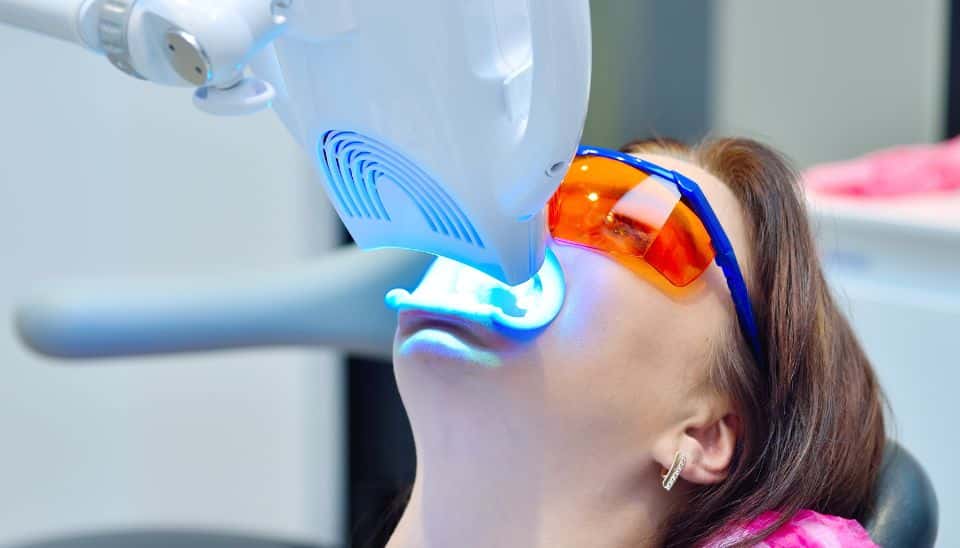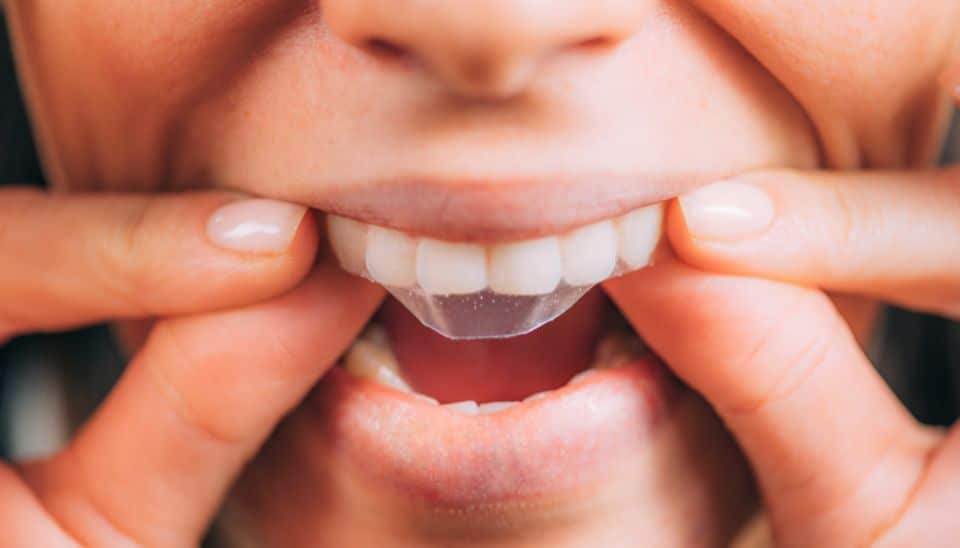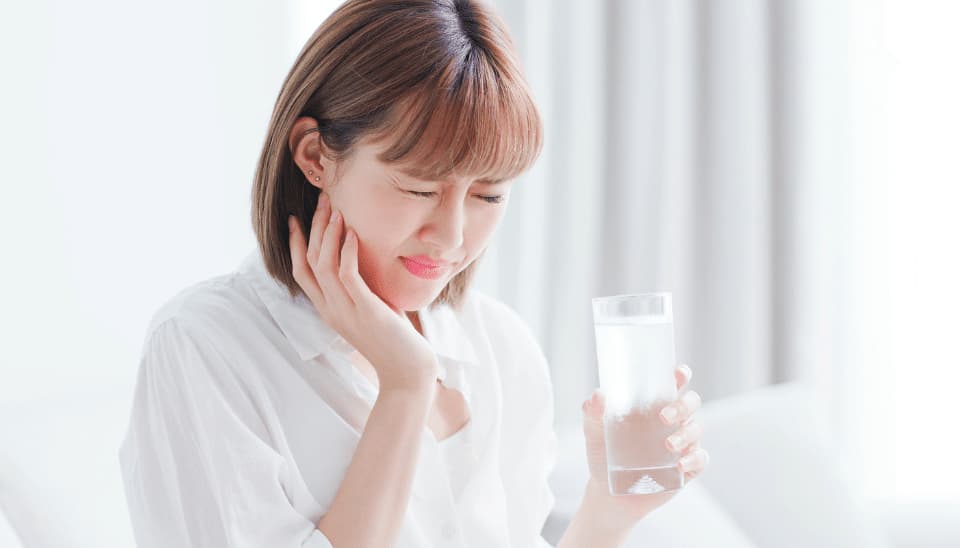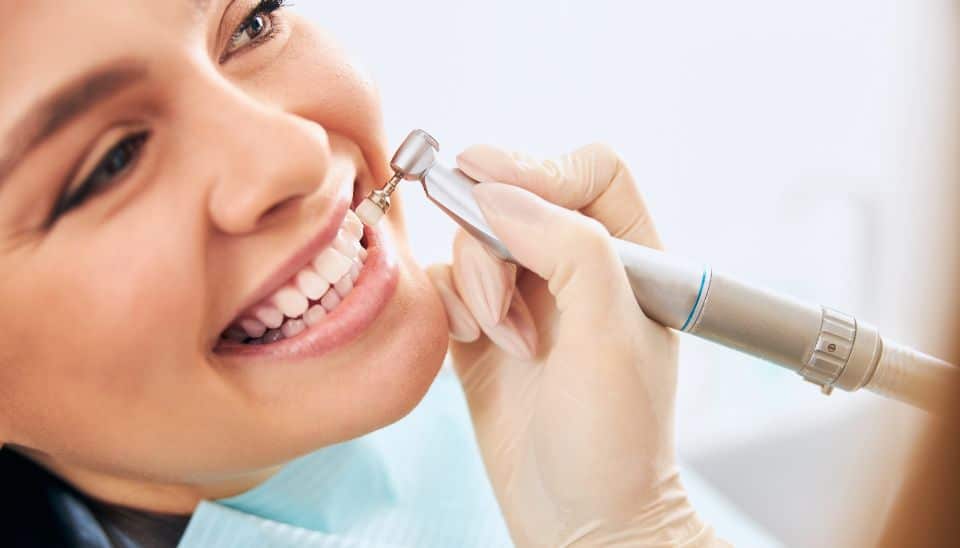A bright, white smile is something many people desire, and with good reason. A whiter smile often boosts confidence, helps with first impressions, and increasingly is seen as part of overall wellbeing. But not all whitening is equal: professional treatments like Zoom® Same Day Whitening differ in significant ways from over-the-counter (OTC) or “at-home” whitening kits. At Hamilton Dental Centre, we believe in helping patients make well-informed choices and do so in a way that protects oral health.
In this post, we’ll compare Zoom vs at-home whitening, highlight benefits and risks, discuss sensitivity, after-care, regulatory issues, and what the latest research tells us. We also reference our earlier post on Teeth Whitening vs Professional Teeth Cleaning so you can see where cosmetic whitening fits into overall dental health.
What Is Teeth Whitening? Key Definitions & How Zoom Fits In
- Tooth whitening/bleaching refers to the process of lightening the colour of teeth using peroxide-based agents (often hydrogen peroxide or carbamide peroxide).
- Over-the-counter (OTC) products include whitening toothpastes, strips, gels, trays, “paint-on” varnishes, pens, or ready-to-use kits (non-prescription). These often have lower concentrations of bleaching agent or slower action. For regulatory definitions, see Over-the-counter drug guidelines.
- Professional whitening, such as our Zoom Same Day service, uses higher concentrations of bleaching agents applied in a dental clinic under controlled conditions (with protective measures for gums, tooth roots, etc.). The light or lamp used with Zoom accelerates the effect, allowing for dramatic shade improvement in one visit.
Zoom Same Day Whitening: What Are the Benefits

Here are the key advantages of having Zoom (or similar in-chair professional whitening):
- Speed/Immediate Results: Zoom can often achieve multiple shade improvements (for some patients up to 6–8 shades lighter) in one appointment. This is especially useful if you want fast results (e.g. for an event).
- Supervised Treatment: Because the dentist or dental professional is overseeing the process, risks (such as gum irritation, overexposure) are reduced. Protective barriers are used, and shade & health of teeth are assessed beforehand.
- Stronger, but Controlled Agents: Higher peroxide concentrations are permissible in-clinic under regulation, so more potent whitening, but applied in a safe way.
- Longer-lasting Colour Stability: In many cases, professional whitening holds better over time if followed by good maintenance.
- Assessment of Baseline Dental Health: Before whitening, a professional can check for cavities, gum disease, and existing restorations, which can affect safety & outcome. (Recall our earlier post Teeth Whitening vs Professional Teeth Cleaning—whitening does not substitute for cleaning or hygiene treatments.)
Over-the-Counter/At-Home Whitening: Benefits & Appeal

OTC whitening has many attractions. Some benefits include:
- Cost: Generally much cheaper than in-clinic whitening.
- Convenience: Can be done at home on your schedule.
- Accessibility: Easily available (pharmacies, online).
- Lower strength/slower action: Which, for some, may reduce the risk of severe sensitivity if used carefully.
Risks & Limitations: Zoom vs At-Home
Both methods carry risks; knowing them helps you make a safe decision.
| Risk / Issue | At-Home / OTC Whitening | Zoom / In-Clinic (Professional) Whitening |
| Tooth Sensitivity | Common; more likely with higher concentrations, longer exposure times, poor tray fit, or misuse. Studies show OTC products cause sensitivity and gum irritation. | Also possible, especially post-treatment, but professional supervision allows mitigations: using desensitising agents, varnishes, adjusting exposure, etc. |
| Gum & Soft Tissue Irritation | Higher risk if trays ill-fitting/gel spread; risk of accidental contact. Some OTC or unregulated kits have caused chemical burns. | Lower risk under professional protection (barriers, control). |
| Enamel Damage / Mineral Loss | Possible if peroxide concentration is high, exposure is too long, or product pH is low. Repeated misuse can lead to surface roughening, enamel softening. | Smaller risk if protocols followed; professionals monitor enamel health, may pre-treat or post-treat to protect enamel. |
| Uneven Whitening / Restoration Mismatch | OTC kits cannot whiten existing restorations (crowns, fillings) and results may be uneven. Colour relapse more common. | Professionals can advise on restoration colour, may adjust or plan accordingly, achieving more uniform shade. |
| Regulation & Safety Concerns | OTC products vary widely; some online kits have dangerous levels of hydrogen peroxide or additives. | Professionals use regulated products; safety, dosage, and efficacy are better documented. |
What the Research Says
- A recent randomised controlled trial compared conventional at-home whitening with higher strength carbamide peroxide (~20%) versus various OTC systems (paint-on gel, ready trays). The professional at-home (prescriber-supervised) approach showed significantly greater colour change (∆E values) and more lasting effect compared to OTC products. OTC systems often had colour relapse by 2 weeks to 6 months.
- A systematic review of OTC whitening agents versus professional or higher-strength peroxide systems showed that while many OTC products are effective for mild extrinsic staining, they underperform for deeper (intrinsic) stains and need longer application periods. They also show higher variation in outcomes and more risk of misuse.
- The American Dental Association highlights that sensitivity is a common side effect; up to two thirds of people may experience transient sensitivity when using strips or tray-based whitening, less so with in-office lower concentrations and with protective measures.
Trends in Teeth Whitening in New Zealand & Globally
- The global teeth whitening market in 2024 was estimated at US$ 7.44 billion, with forecasts to reach about US$ 8.94 billion by 2029.
- The NZ market for teeth whitening systems (both in-office and take-home devices) was valued at over NZD 0.7 million in 2023.
- Growth drivers include increased interest in cosmetic dentistry, social media influence (“perfect smile” aesthetic), accessibility of OTC kits, and greater willingness to invest in appearance and self-confidence.
Zoom at Hamilton Dental Centre: What Makes It Different
To help you understand how we stand apart, here are key differentiators of Zoom Same Day at Hamilton Dental Centre:
- We use professionally licensed agents with known concentration & safety profile.
- All treatments are overseen by qualified dental professionals who assess your teeth and gums first.
- Protective measures (gums, lips, soft tissue) are in place to reduce the risk of chemical burn.
- After-care is built in: we provide guidance on after-care tips (see our detailed post “After-Care for Teeth Whitening”) so your whitening lasts longer.
- We factor in sensitivity: if you have known sensitivity, we can do pre-treatments (desensitising gel, adjust protocols) or use gentler methods. (Also see our earlier post “Managing Tooth Sensitivity in Whitening”.)
Sensitivity: What to Know & How to Mitigate

Tooth sensitivity is one of the most common adverse effects of whitening. Some things to know:
- Why it occurs: Peroxide agents can penetrate enamel/dentine, triggering nerve irritation. Thinner enamel or exposed roots make sensitivity more likely.
- When it often arises: usually early in treatment (first few days), or when concentrations or exposure times are higher.
- How long it lasts: often mild and temporary, resolving a few days after treatment ends or with use of desensitising agents.
- Mitigation strategies: use lower-concentration gels or peroxide; shorter exposure times; pre-treatment with desensitising pastes (e.g. ones with potassium nitrate or fluoride); using custom-fitted trays; professional supervision.
After-Care & Maintenance
To preserve whitening results and protect tooth health, after-care is crucial. Some tips:
- Avoid strongly staining foods/drinks for at least 48 hours post-treatment (coffee, tea, red wine, berries, sauces, etc.).
- Maintain excellent oral hygiene: brushing, flossing, and maybe using a whitening maintenance toothpaste.
- Use touch-ups as recommended (dentist-supervised) rather than repeatedly using OTC products aggressively.
- Wear trays or use maintenance products as advised.
- Regular dental cleanings help remove surface stains and plaque that might reduce whitening’s appearance.
For more detailed after-care instructions, see our Hamilton Dental Centre post: After-Care for Teeth Whitening.
Comparing Whitening vs Professional Cleaning (From Our Earlier Post)

As we discussed previously in “Teeth Whitening vs Professional Teeth Cleaning”, teeth cleaning is essential for maintaining oral health, removing plaque & calculus, and preventing gum disease. Whitening removes or lightens stains but does not replace the need for cleaning. If stains (extrinsic) are sitting atop thick calculus or plaque, whitening may not reach under those layers, and results will be limited. Also, cleaning helps prepare teeth so whitening agents can work more evenly.
Safety, Regulation & What to Watch Out for
- Always check that whitening products have regulatory approval (in New Zealand or your jurisdiction). Some online/OTC kits have been seized or withdrawn for using unsafe levels of hydrogen peroxide.
- Ask about the concentration (percent peroxide) and whether the kit or system has clinical studies to back claims.
- Be cautious of very cheap “light” or “LED” kits that promise dramatic whitening quickly – they may use low-quality materials or unsafe levels.
- Always disclose existing dental work (crowns, fillings, veneers), history of sensitivity, gum recession etc. Some restorations will not whiten and may become more obvious if natural teeth lighten.
Summary: What We Recommend
If you are looking for:
- Fast, noticeable results in one visit → Zoom at the clinic is best.
- Safety and supervision, better uniformity, and long-lasting effect → professional whitening.
- Cost-effective or mild enhancement and are okay with slower results, possibly repeated treatments → OTC / at-home can work, but must be used carefully.
If you have sensitivity, existing restorations, gum issues, or especially want a dramatic change, a professional consultation is highly recommended.
FAQ
Does Zoom whitening hurt?
Some people do experience mild sensitivity during or after treatment, especially to hot or cold, but this is usually temporary. We use protective measures and desensitising agents to minimise discomfort. See our post Managing Tooth Sensitivity in Whitening.
How much whiter will my teeth get with Zoom compared to OTC kits?
Zoom often achieves several shades of difference in one visit, which OTC kits usually take many weeks to match (if at all). Research shows wide variation in OTC outcomes; often their effect plateaus and may relapse faster.
Are the results permanent?
No whitening is truly permanent – lifestyle (diet, smoking, oral hygiene) affects how quickly stains return. But with good after-care, touch-ups, and avoiding staining substances, you can maintain results for many months to years.
Is whitening safe if I have dental restorations (crowns, veneers)?
Whitening agents do not change the colour of porcelain, composite or other non-enamel materials. If you have restorations that are visible, those may need updating after whitening to match. A professional evaluation can plan for that.
Can I use OTC whitening products in between professional treatments?
Yes, when used correctly, mild OTC options can help maintain shade. But avoid over-use. Always follow instructions, ensure trays fit properly, and avoid using high concentrations without advice.
How much does Zoom cost, and is it worth it vs cheaper home kits?
While the upfront cost of clinic whitening is higher, because it’s faster, safer (less risk of damage or sensitivity), and more reliably effective, many find the cost is justified for better value overall. (Cheaper kits sometimes lead to repeated purchases or worse, dental complications.) At Hamilton Dental Centre we can provide a quote and compare options for you.
If you’re considering teeth whitening, we’d love to help you choose the best path. Feel free to contact us at Hamilton Dental Centre for a consultation – we will assess your teeth (colour, restorations, sensitivity), explain options (including Zoom Same Day), and help you safely achieve a whiter smile.
References
- “Tooth Whitening: What We Now Know,” PMC / Clifton M. Carey et al. (2014). PubMed Central
- “Evaluating the efficiency of two different over-the-counter tooth whitening systems…” (2024) Nature
- American Dental Association – whitening & sensitivity info. Ada
Site map
Services
Contact Us
T: 07 854 8905
E: info@thehdc.co.nz
3/111 Thomas Road,
Rototuna, Hamilton
copyright © 2025 Hamilton Dental Centre | Credit Terms | Web development by Digital Hothouse

